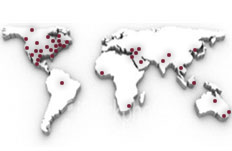SIRIS™ Smart Infrared Inspection System
Nature of the Problem
The inspection of commercial motor vehicles is mandated by a variety of Federal and state laws and regulations. With literally millions of CMVs on the nation’s highways at any moment, the task of selecting vehicles for inspection has become a major concern. The effectiveness of thermal infrared technology for pre-screening CMVs for inspection has been well established for many years. The application of this technology in actual inspection settings, however, had not become commonplace for several reasons:
- The process is labor intensive, often requiring several dedicated inspectors to watch computer screens or dedicating limited resources to manning handheld devices
- Most thermal inspection systems only observed one side of the vehicle, leaving the other side uninspected
- The cost to own most systems was high both in terms of capital expenditure and even moreso in terms of labor
IEM Solution
IEM worked in cooperation with the Federal Motor Carrier Safety Administration, the Tennessee Department of Safety, the New York State Department of Transportation and State Police, the University of Michigan Transportation Research Institute, and Oak Ridge National Laboratory to develop the world’s first automated thermal inspection system.
SIRIS™, which is now a final product offered by IEM, arose from IEM’s prior work in developing wayside railroad inspection systems and our core understanding of thermal imaging technology.
The development of SIRIS™ automated inspection technology offers a good model of how IEM leverages government sponsored R&D funds to discover and advance solutions to critical public policy issues:
1. Identify the nature of the problem. IEM reviewed prior research and field testing of thermal imaging technology and identified the core issues for current technology
2. Develop a Concept of Operations that identifies the desired features and benefits of the devices. For SIRIS™ this entailed operation at a roadside weigh station or inspection facility for prescreening purposes.
3. Develop a set of preliminary technical and performance specifications that define how the system must perform to achieve the operational goals. In the case of SIRIS this entailed specific hardware and software requirements.
4. Build prototype system for initial field testing. IEM field the first version of SIRIS™ at a weigh station in Tennessee and collected data from thousands of passing trucks.
5. Refine the system design based on the results of the early field testing and undertake a test program that resulted in a combination of SIRIS™ thermal data that could be directly correlated with results of Level 1 truck inspections.
6. Perform a statistical analysis of the data to identify patterns in thermal data that may be related to specific Level 1 inspection findings.
7. Use the statistical results to define a set of rules for evaluation of the thermal data and instantiate those rules into the SIRIS software.
8. Develop a user interface that can be used to alert inspectors when a vehicle is flagged for inspection.
9. Perform a series of tests to demonstrate the effectiveness of the system.
IEM completed this process for SIRIS™, resulting in a fielded system capable of automatically evaluating every CMV that passes through it. Based on a series of field tests, including blind tests where inspectors were unaware of whether or not the vehicle had been flagged by SIRIS™, the technology has proven to be exceptionally accurate, with more than 80% of vehicles flagged by SIRIS™ being placed Out of Service for a serious problem.


